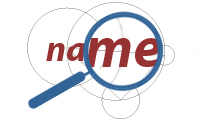Research into names
 Within the discipline of name research, also known as onomastics, a distinction is drawn between two basic types of substantives, commonly referred to as nouns: proper names and appellatives.
Within the discipline of name research, also known as onomastics, a distinction is drawn between two basic types of substantives, commonly referred to as nouns: proper names and appellatives.
A noun that is a proper name is a 'real' name and points to one particular specimen, one individual occurrence of something. The term proper name comes from the Latin word proprius that means 'own', 'personal' or 'particular'. In Danish we can also use the term egennavn. We always write proper names with an initial capital letter.
A noun that is an appellative is a term that can be used of several objects of the same sort. Appellative means 'calling' or 'designating' and in Danish we can also call an appellative a fællesnavn 'common noun'.
The word sten is, for example, an appellative that refers to a geological phenomenon, a material or something that is normally found on the ground. When one particular man bears the name Sten, however, the appellative has become a proper noun. The same thing happens when the appellative havn becomes the name of the town Havn (subsequently København – Copenhagen) and it is in the course of this process that the words become of interest for onomastics, i.e. name research.
Name research section
In Denmark the only official centre for organised name research is the Name research group at the Department of Nordic Studies and Linguistics of the University of Copenhagen.
Name research is first and foremost a linguistic discipline, involving the history of the Danish language, its grammar and semantics – the study of the meaning of words. In addition attention is paid to the individual names and name-types and their origin and meaning as well as their employment both today and in olden times.
The reason why research into names is an independent linguistic discipline is mainly because names are among the oldest linguistic evidence that we have about the Danish language. Written sources are scarce before the 13th to 14th century, and earlier medieval documents in Latin rarely contain any other linguistic material in Danish than precisely names.
Similarly, from the Viking Age (c. 800-1060 AD) and earlier, there are only some brief runic inscriptions that typically only contain succinct information about a few individuals and consequently their names. Rather more infrequently the inscriptions sometimes mention place-names – for example when Tanmaurk (Denmark) stands on the great Jelling runestone that is often taken to be a kind of birth certificate for Denmark.
In this way the names are our very best sources for the earliest stages in the development of our language. One might be tempted to say that apart from the names our ancestors from the pre-medieval period have not left us very much information about their language.
